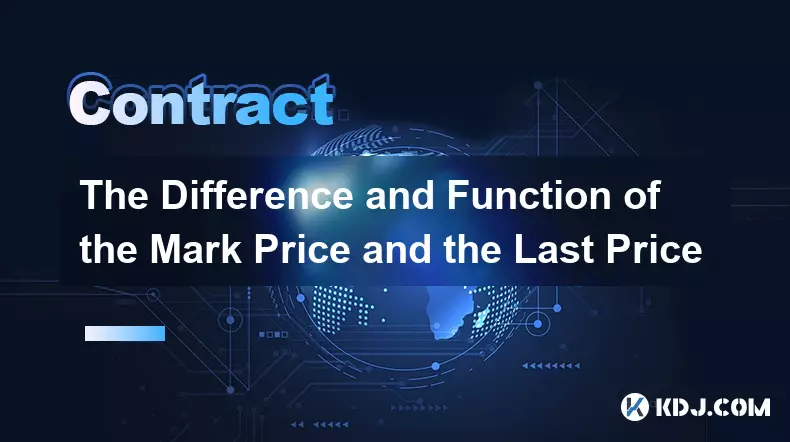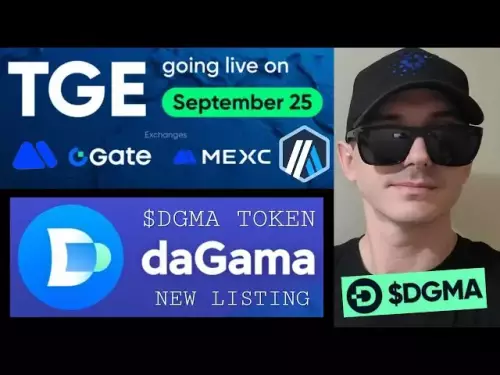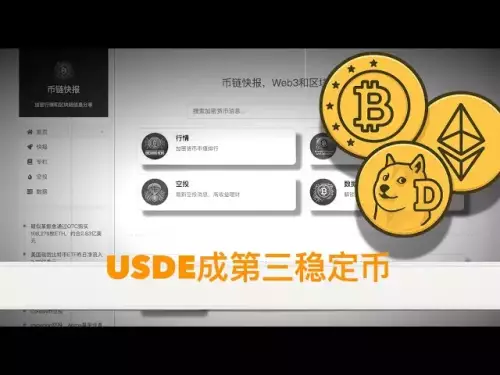-
 bitcoin
bitcoin $112371.712755 USD
-0.18% -
 ethereum
ethereum $4188.969598 USD
-0.18% -
 tether
tether $1.000202 USD
-0.05% -
 xrp
xrp $2.834903 USD
-0.51% -
 bnb
bnb $1021.658413 USD
3.04% -
 solana
solana $215.188750 USD
-1.77% -
 usd-coin
usd-coin $0.999803 USD
0.00% -
 dogecoin
dogecoin $0.239438 USD
-0.51% -
 tron
tron $0.336588 USD
-1.10% -
 cardano
cardano $0.812415 USD
-1.22% -
 hyperliquid
hyperliquid $45.019578 USD
-2.90% -
 chainlink
chainlink $21.594825 USD
-0.13% -
 avalanche
avalanche $34.271321 USD
2.56% -
 ethena-usde
ethena-usde $1.000931 USD
-0.07% -
 sui
sui $3.354033 USD
-0.29%
The Difference and Function of the Mark Price and the Last Price
The mark price prevents unfair liquidations in crypto derivatives by using a stable, index-based reference, protecting traders from volatility and manipulation.
Sep 22, 2025 at 08:01 am

The Role of Mark Price in Crypto Derivatives Trading
1. The mark price serves as a critical mechanism to prevent unfair liquidations in cryptocurrency futures and perpetual swap contracts. Unlike traditional financial markets, crypto exchanges operate 24/7 with high volatility, making it essential to use a more stable reference point than the last traded price.
- It is typically derived from the underlying asset’s spot price across multiple external exchanges, often using a time-weighted average price (TWAP) or index-based calculation. This ensures that short-term manipulation or flash crashes do not trigger mass liquidations.
- Exchanges like Binance, Bybit, and OKX use mark price to calculate unrealized profit and loss (PnL) for open positions, as well as funding rates in perpetual contracts. This protects traders from sudden slippage caused by illiquid order books.
- The mark price acts as a safeguard against price manipulation, especially during periods of low liquidity or extreme market movements. When the last price deviates significantly from the mark price, the system may delay or adjust liquidation triggers accordingly.
- Funding payments between long and short positions are also calculated based on the difference between the mark price and the last price, ensuring fairness in the perpetual swap ecosystem.
Understanding the Last Price in Market Dynamics
1. The last price refers to the most recent transaction executed on a trading pair within a specific exchange. It reflects real-time supply and demand but can be highly volatile in fast-moving crypto markets.
- Traders often rely on the last price when placing market orders or assessing current entry and exit points. However, due to thin order books on some platforms, this price can be easily influenced by large trades or spoofing.
- In derivatives trading, the last price determines the execution level of take-profit and stop-loss orders. Yet, because it doesn’t account for broader market conditions, it may not represent fair value at any given moment.
- During periods of high volatility—such as major news events or macroeconomic shifts—the last price can diverge sharply from the underlying asset’s true market equilibrium. This increases the risk of premature liquidations if used alone for margin calculations.
- While the last price indicates actual trade activity, its susceptibility to manipulation makes it unreliable as the sole basis for critical risk management decisions. That’s why advanced trading platforms incorporate additional layers like mark price.
How Mark Price and Last Price Interact in Risk Management
1. When opening a leveraged position, both prices are monitored simultaneously. The mark price determines whether a position is nearing liquidation, while the last price affects realized gains or losses upon closing.
- If the last price moves rapidly beyond the mark price due to a sudden spike or drop, the system continues to use the mark price to assess margin health. This prevents cascading liquidations triggered by temporary imbalances.
- Arbitrage opportunities arise when there’s a significant gap between the two prices. Sophisticated traders may exploit these discrepancies through cross-exchange strategies or hedging with spot positions.
- Exchanges apply insurance funds precisely because of the divergence between mark and last prices, absorbing losses when forced liquidations occur under stressed conditions. These funds help maintain platform stability during black swan events.
- Users should always check the liquidation price relative to the mark price rather than the last price when managing high-leverage positions. Misunderstanding this distinction can lead to unexpected exits from profitable trades.
Frequently Asked Questions
What causes the difference between mark price and last price?Discrepancies occur due to delays in price feeds, low trading volume, sudden surges in buy or sell pressure, and varying methodologies used by exchanges to compute the mark price. High volatility amplifies these gaps.
Can the mark price be manipulated?It is significantly harder to manipulate compared to the last price, as it relies on aggregated data from multiple sources and often includes time-smoothed averages. However, if an index provider is compromised, indirect influence remains possible.
Do all crypto exchanges use mark price for liquidations?Most reputable platforms handling derivatives—such as BitMEX, Kraken Futures, and FTX (prior to its collapse)—use mark price models. Spot trading does not involve mark price mechanics, as no leverage is involved.
Is the last price still relevant if mark price is more stable?Absolutely. The last price reflects real executable levels and is crucial for order execution, chart analysis, and determining trade confirmation. It complements the mark price but shouldn't override it in risk-critical functions.
Disclaimer:info@kdj.com
The information provided is not trading advice. kdj.com does not assume any responsibility for any investments made based on the information provided in this article. Cryptocurrencies are highly volatile and it is highly recommended that you invest with caution after thorough research!
If you believe that the content used on this website infringes your copyright, please contact us immediately (info@kdj.com) and we will delete it promptly.
- Bitcoin, Ethereum, Forecasts: Navigating the Crypto Landscape in 2025
- 2025-09-25 00:25:12
- SHIB, Coinbase, and Shiba Inu: Whale Moves and Market Dynamics
- 2025-09-25 00:25:12
- XRP Investors Eye Altcoins: Paydax Protocol's Profit Potential
- 2025-09-25 00:30:01
- Crypto Picks 2025: Meme Coins Roaring into the Future
- 2025-09-25 00:30:01
- FTX Token's Wild Ride: SBF's 'gm' Sparks Frenzy, Account Activity Under Scrutiny
- 2025-09-25 00:30:01
- Financial Freedom with Pi Network: Real Value in a Digital Age
- 2025-09-25 00:30:13
Related knowledge

How do I enable the "scalping-only" mode for Cardano (ADA) contracts?
Sep 24,2025 at 03:19am
Understanding Scalping Strategies in Crypto Derivatives1. Scalping in cryptocurrency trading refers to executing multiple short-term trades within min...

What is the maximum position limit for Cardano (ADA) contracts?
Sep 23,2025 at 11:00pm
Understanding ADA Futures and Derivatives Market Structure1. Cardano (ADA) futures contracts are offered by several major cryptocurrency derivatives e...

How can I view open interest in Cardano (ADA) contracts?
Sep 24,2025 at 07:36am
Understanding Open Interest in Cardano Derivatives1. Open interest refers to the total number of outstanding derivative contracts, such as futures or ...

What is the function of the insurance fund in Cardano (ADA) contracts?
Sep 24,2025 at 02:18am
Understanding the Role of Insurance Funds in Cardano Smart Contracts1. The insurance fund within Cardano's ecosystem is not a native feature directly ...

How can I view historical transaction records for Cardano (ADA) contracts?
Sep 24,2025 at 04:01pm
Understanding Cardano's On-Chain Data Structure1. Cardano operates on a proof-of-stake blockchain that records all transactions in blocks secured thro...

How is the funding rate charged for Cardano (ADA) contracts?
Sep 24,2025 at 07:19am
Funding Rate Mechanism for Cardano (ADA) Perpetual Contracts1. The funding rate in Cardano perpetual contracts serves as a mechanism to align the pric...

How do I enable the "scalping-only" mode for Cardano (ADA) contracts?
Sep 24,2025 at 03:19am
Understanding Scalping Strategies in Crypto Derivatives1. Scalping in cryptocurrency trading refers to executing multiple short-term trades within min...

What is the maximum position limit for Cardano (ADA) contracts?
Sep 23,2025 at 11:00pm
Understanding ADA Futures and Derivatives Market Structure1. Cardano (ADA) futures contracts are offered by several major cryptocurrency derivatives e...

How can I view open interest in Cardano (ADA) contracts?
Sep 24,2025 at 07:36am
Understanding Open Interest in Cardano Derivatives1. Open interest refers to the total number of outstanding derivative contracts, such as futures or ...

What is the function of the insurance fund in Cardano (ADA) contracts?
Sep 24,2025 at 02:18am
Understanding the Role of Insurance Funds in Cardano Smart Contracts1. The insurance fund within Cardano's ecosystem is not a native feature directly ...

How can I view historical transaction records for Cardano (ADA) contracts?
Sep 24,2025 at 04:01pm
Understanding Cardano's On-Chain Data Structure1. Cardano operates on a proof-of-stake blockchain that records all transactions in blocks secured thro...

How is the funding rate charged for Cardano (ADA) contracts?
Sep 24,2025 at 07:19am
Funding Rate Mechanism for Cardano (ADA) Perpetual Contracts1. The funding rate in Cardano perpetual contracts serves as a mechanism to align the pric...
See all articles


























![[Pycoin] PI Coin -Binance listed?! I don't need it .. This is possible / How to accelerate mining #paikoin [Pycoin] PI Coin -Binance listed?! I don't need it .. This is possible / How to accelerate mining #paikoin](/uploads/2025/09/24/cryptocurrencies-news/videos/pycoin-pi-coin-binance-listed-don-accelerate-mining-paikoin/68d3eb6cdf417_image_500_375.webp)















































